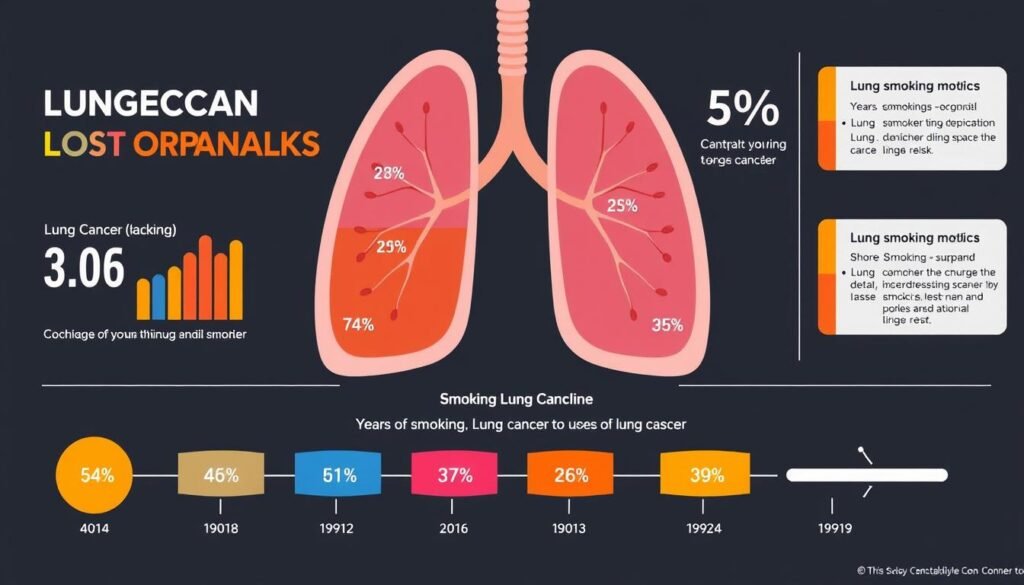It’s shocking to know that 9 out of 10 lung cancer deaths in the U.S. are from smoking. This fact comes from the Centers for Disease Control and Prevention. It shows how smoking badly affects lung health. It also talks about the high costs for treating lung cancer. Knowing how long you need to smoke to get lung cancer is key. It helps raise awareness and shows the possible costs of treatment.
Smoking and lung cancer have a clear link. It’s important to teach both current and former smokers about their risk. Lung cancer treatments can be very expensive for those affected. Understanding this is vital as we tackle the health problems caused by tobacco use. We’ll look into how smoking relates to lung cancer risk. We’ll also discuss the statistics and what this means for treatment.
Key Takeaways
- Up to 90% of lung cancer deaths are due to smoking.
- Smokers have a significantly higher risk of developing lung cancer compared to non-smokers.
- Long-term smoking may result in substantial financial strain from lung cancer treatment costs.
- Over half of current smokers are likely to develop lung cancer by age 80.
- Even after quitting, individuals remain at risk for lung cancer for many years.
- Lung cancer screening is recommended for individuals with a history of smoking.
Introduction to Smoking and Lung Cancer
Smoking greatly increases the risk for serious health issues, such as lung cancer. Studies have shown a strong link between smoking and lung cancer. Smoking plays a key role in the high incidence of the disease among diverse groups.
Up to 85% of lung cancer cases are tied to tobacco use. This shows how critical it is to raise awareness about smoking and lung health. Even occasional smoking can raise the risk of lung cancer significantly.
Dealing with lung cancer from smoking also means facing high costs. The yearly cost for a patient can be up to $139,801. Smokers often pay more due to complications from using tobacco for a long time. It’s essential to know about financial help and insurance cover, including Medicare and Medicaid. For extra details on treatment costs, go here.
The Relationship Between Smoking and Lung Cancer
The smoking cancer connection is strong, with studies showing about 85% of lung cancer cases are linked to smoking. Cigarettes have many carcinogens that harm lung tissues. This helps cancer grow. Knowing how smoking causes lung cancer starts with the bad substances inhaled. These cause genetic changes in cells. These changes can lead to wild cell growth, which can become cancer.
Lung cancer has big financial impacts. The costs for treating it change based on the stage of the cancer. For example, here are the costs:
| Stage | Cost per Patient |
|---|---|
| Stage I | $13,456 |
| Stage II | $35,648 |
| Stage III | $106,186 |
| Stage IV | $144,555 |
The average yearly cost per patient is an amazing $139,801. Smoking is responsible for about $92,269 of this. Stage IV lung cancer makes up 96% of costs linked to smoking. With smoking expected to cause 8 million deaths by 2030, mostly in poor countries, it’s not just a personal issue. It affects health systems worldwide.
Early screenings combined with stopping smoking could save money and lives. Research shows preventing smoking is key. There’s no safe amount of smoking. Every cigarette does more harm. This shows why quitting is so important.
Understanding Risk Factors for Lung Cancer
Knowing what increases lung cancer risk is key to stopping it early. The length of time and amount one smokes greatly affect their chances of getting this serious disease. Smoking a lot over many years is a big cause of lung cancer deaths.
Duration of Smoking
The longer someone smokes, the higher their lung cancer risk. Long-time smokers face more danger than those who smoked for a shorter period. Every extra year of smoking means more exposure to toxins that could turn lung cells cancerous.
Quantity of Cigarettes Smoked
How many cigarettes you smoke each day also matters a lot. People who smoke a lot each day are at a much higher risk. Smoking a lot for many years makes it even more likely to get lung cancer. Knowing how much and how long people have smoked helps find those at greatest risk. They can then get checks and help early. For more details on early signs and risks, click here.
| Risk Factors | Impact |
|---|---|
| Duration of Smoking | Prolonged exposure increases likelihood of lung cancer |
| Quantity of Cigarettes Smoked | Higher intake raises cancer risk significantly |
| Secondhand Smoke Exposure | Increases risk, particularly in non-smokers |
| Genetic Predisposition | Family history may enhance risk factors |
| Occupational Carcinogens | Exposure in certain jobs can elevate lung cancer risks |
Statistics on Lung Cancer and Smoking
Smoking is a major reason behind lung cancer, linked to 85% of all cases. Around 48.3% of smokers might get lung cancer by 80 years old. People who don’t smoke have a much lower chance of getting it.
In the US, lung cancer is the second most common cancer. We expect about 234,580 new cases in 2024. This includes 116,310 men and 118,270 women. The expected number of deaths from lung cancer that year is 125,070. This shows how deadly the disease is. About 25% of all cancer deaths are due to lung cancer.
To show how smoking and lung cancer are connected, look at these numbers:
| Statistic | Value |
|---|---|
| Percentage of smokers likely to develop lung cancer by age 80 | 48.3% |
| New lung cancer cases expected in 2024 | 234,580 |
| Estimated lung cancer deaths in 2024 | 125,070 |
| Lung cancer’s proportion of all cancer deaths | 25% |
| Risk of a man developing lung cancer in his lifetime | 1 in 16 |
| Risk of a woman developing lung cancer in her lifetime | 1 in 17 |
Lung cancer numbers show a clear link with smoking. As fewer people smoke, we might see less lung cancer in the future.

How Long Do You Typically Have to Smoke to Develop Lung Cancer?
Learning about the timeline for lung cancer development is essential for understanding the risks of smoking. There’s no certain time frame that guarantees lung cancer, but the risk grows with how long and how much you smoke. Even smoking for a short period can harm your lungs.
About 90% of lung cancer cases are due to cigarette smoking. This fact highlights the dangerous link between smoking and lung cancer. In the United States, lung cancer is the top cause of cancer deaths, with smokers being at high risk. The risk increases the longer you smoke, highlighting the need for education on this issue.
Those who keep smoking after being diagnosed are more likely to face serious problems. If you smoke at the time you’re diagnosed, your chances of surviving are lower compared to non-smokers. Even being exposed to smoke for a few years can have harmful effects that last.
Stopping smoking at any time can greatly help your health, research shows. If you continue to smoke after finding out you have cancer, it can lower your chances of living longer. So, how long and how much you’ve smoked really matters in the risk of getting lung cancer.
| Duration of Smoking (Years) | Increased Risk of Lung Cancer |
|---|---|
| 1-5 | Low Risk |
| 6-10 | Moderate Risk |
| 11-20 | High Risk |
| 20+ | Very High Risk |
The table shows how the risk of lung cancer grows with every year you smoke. Each step up in the number of years smoked increases your risk. It’s important to think about how much and how long you’ve smoked.
What Percent of Smokers Develop Lung Cancer?
The link between smoking and lung cancer is striking. Recent lung cancer in smokers statistics show that about 87% of lung cancer deaths in the US are from smoking. Especially, heavy smokers have a high chance of getting lung cancer.
Research shows alarming rates of smokers who might get lung cancer in their lifetime. About 5.7% of people have a lifetime risk of lung cancer. For people who smoke now, the risk is much higher. This shows through the increased rates of lung cancer in these groups:
| Smoker Type | Incidence Rate (per 1000 person-years) |
|---|---|
| Current Smokers | 1.97 |
| Former Smokers | 1.61 |
| Never Smokers | 0.26 |
This data shows the real risk of lung cancer in smokers. For heavy smokers, the risk stays high even after they quit. Studies indicate that about 39.1% of lung cancers in former smokers occurred over 15 years after quitting.
In 2024, lung and bronchus cancer are expected to make up 234,580 new cases. This is 11.7% of all new cancer cases. Shockingly, 20.4% of all cancer deaths will be from lung cancer. This underlines the serious effect of lung cancer on health.

Understanding the link between smoking and lung cancer can push people to think about their risks and quitting. The data does not just highlight the dangers of smoking. It also shows why regular screenings are crucial for anyone who smoked a lot before.
Common Types of Cancer Caused by Smoking
Smoking raises the risk of lung cancer a lot. It also leads to many other types of cancer. Knowing these can help people see how bad tobacco is. About 85% of lung cancer comes from smoking. Yet, tobacco hurts more than just the lungs.
Other Health Risks Associated with Smoking
Smoking’s dangers go beyond cancer. Here are some cancers and health problems from smoking:
- Bladder Cancer: Smoking doubles your chance of getting bladder cancer.
- Kidney Cancer: If you smoke, you’re more likely to get kidney cancer.
- Esophageal Cancer: Using tobacco greatly increases esophageal cancer risk.
- Oral and Throat Cancers: Smoking causes mouth, throat, and voice box cancers.
- Pancreatic Cancer: There’s a strong link between smoking and pancreatic cancer.
- Respiratory Diseases: Smokers often have diseases like COPD and emphysema.
- Cardiovascular Issues: Smoking makes heart disease and strokes more likely.
Tobacco use is linked to many smoking-related cancers. It’s important to know the big health risks of smoking. This encourages people to choose a healthier life.
Does Quitting Smoking Reduce the Risk of Lung Cancer?
Quitting smoking greatly improves one’s health, especially in reducing lung cancer risk. Before turning 35, those who stop smoking almost cut out their extra risk of dying from cancer or other causes. This big decrease shows the benefits of quitting at any age.
In the United States, 34 million adults still smoke. They are three times more likely to die from cancer than non-smokers. About 70% of cancer deaths and up to 60% of heart-related deaths in smokers are due to tobacco. This shows how important it is to quit smoking.
Quitting early in life brings big benefits. People who quit from 15 to 34 can dodge nearly all the added risk of cancer death. Even those who’ve smoked for years can see major health gains. Lowering lung cancer risk starts soon and improves over time. This tells us it’s never too late to quit.
Tobacco causes 85% to 90% of lung cancer cases worldwide. Quitting smoking helps people heal and lowers their cancer risk as time goes on. Knowing these benefits can push people to start a smoke-free life.
To learn more about the benefits of quitting smoking, check out this resource. It has good info on how stopping smoking fights lung cancer and other smoking-related illnesses.
How Much Does Lung Cancer Treatment Cost?
Lung cancer treatment costs can really stress patients and their families. Knowing the lung cancer treatment cost helps in planning your finances better. The cost changes based on treatment type, how long it lasts, and more needs.
For lung cancer, the cost of cancer therapy is around $68,293 at the start, says the National Cancer Institute. This shows the lung cancer expenses can really vary. By 2015, the U.S. spent $190.2 billion on cancer care, expected to reach $246.6 billion by 2030.
- Each year, patients and their families pay about $5.6 billion themselves for treatment.
- A lot of cancer survivors, between 12% to 62%, end up in debt because of treatment costs.
- Lung cancer costs can differ based on insurance, deductibles, and copays, adding to the total lung cancer treatment cost.
To deal with lung cancer expenses, some strategies can help. Working with financial counselors, checking insurance details, and looking for financial aid are good steps. There are nonprofits that help with cancer costs, including help from Medicare, Medicaid, and drug programs.
| Cost Type | Estimated Amount |
|---|---|
| Average Initial Care Cost for Lung Cancer | $68,293 |
| Annual Out-of-Pocket Expenses for Cancer Treatment | $5.6 billion |
| Total Cost of Cancer Care (2015) | $190.2 billion |
| Projected Total Cost of Cancer Care (2030) | $246.6 billion |
The big financial impact of lung cancer is clear. Planning well is key for patients and their families. Getting ahead of the financial burden with good strategies and using available aids can help lessen the stress of high treatment costs.
The Financial Burden of Lung Cancer Treatment
Lung cancer treatment comes with huge costs. Patients deal with complex bills and insurance issues. This can be very stressful. Knowing about financial help can ease some worry. It’s also key to have a plan for handling these costs.
Lung Cancer Treatment Financial Assistance Options
Many places offer help with lung cancer costs. This includes charities, government programs, and nonprofits. They provide things like co-payment help, grants, and financial advice. These can help lower the burden.
- Nonprofit Organizations: Organizations like the Cancer Financial Assistance Coalition help with cancer costs.
- Government Programs: Medicaid and Medicare might help people with their medical bills.
- Patient Assistance Programs: Some drug companies have programs to help patients buy medicine.
Managing Lung Cancer Medical Bills
Organizing your finances is important when dealing with cancer costs. Understanding your bills and getting help is crucial. Keep track of all expenses and talks with your insurance.
- Consult your healthcare provider: Talk about financial help when you see your doctor.
- Contact your insurance company: Make sure you know what your policy covers.
- Evaluate payment plans: Hospitals sometimes offer plans that make paying easier.
- Seek community resources: Local groups can offer advice on handling medical bills.
In 2019, cancer care had a big cost impact – $21.09 billion in lost time and out-of-pocket expenses. Lung cancer’s share was $1.35 billion. For older adults, beginning and end-of-life care costs were high. This shows the need for careful budgeting and planning.

| Type of Cost | 2019 Total ($ Billions) | Lung Cancer Costs ($ Billions) |
|---|---|---|
| Out-of-Pocket Costs | 16.22 | 1.35 |
| Time Costs | 4.87 | Not available |
| Overall Cancer Care Cost | 21.09 | Not available |
The costs for patients at start and end stages are high. Planning and support are key to manage these expenses well.
Conclusion
Understanding the link between smoking and lung cancer is vital. Research shows that smoking more increases your risk of this disease. With over 222,500 new cases in the U.S. each year, awareness and prevention are key.
Lung cancer treatment can be very costly. Before diagnosis, healthcare costs can be up to $861 a month. Costs rise with surgery and treatments like chemotherapy, highlighting the need for preventive measures.
Quitting smoking has huge benefits for health and finances. It lowers your chance of getting lung cancer and eases treatment costs. By understanding the smoking-lung cancer connection, you can make better choices for your health and money.